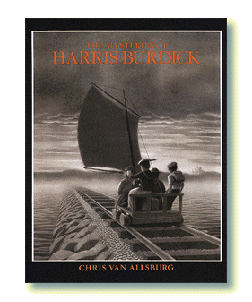The Mysteries of Harris Burdick
compiled by Chris Van Allsburg
written & illustrated by Harris Burdick

If you asked someone to list the main characteristics of a book – the components that all books have, regardless of their genre – one of the most common answers would probably be an obviously determined plotline. The idea that in order to be considered a story, a book must have a clear beginning, a middle, and an end is one that we have been taught since we first entered school. A book that ventures outside of this mindset is very rare, but not necessarily a bad thing. Chris Van Allsburg’s The Mysteries of Harris Burdick is one text that breaks this traditional mold. Originally published in 1984, Van Allsburg (who is also the author of The Polar Express and Jumanji) compiles fourteen images that were given to a former book publisher named Peter Wenders back in the 1950s. A man who identified himself as Harris Burdick came to Wenders’ office one day and dropped off illustrations from fourteen different books he claimed to have written. He promised to come back the next day with the stories themselves, but didn’t return. Peter Wenders, still determined to publish these books, searched for his former visitor but was never able to locate Burdick or any information about him whatsoever. Over 50 years have passed and the stories behind the illustrations are still a mystery. Van Allsburg provides an introduction at the beginning of the book containing this brief history of the images, which I think greatly adds to readers’ ability to appreciate its contents.
During his visit, Harris Burdick left a title and caption to accompany each illustration. Some of the titles have an obvious relationship with the picture, while others seem to have no connection (leaving us to wonder what exactly the backstory might be). It appears as though each picture and caption were taken directly out of the middle of their stories, as they casually refer to things such as “he” and “it”- implying that the reader will already know. Every image is captivating, and when paired with its respective text, leaves you wanting to know the origins of the story. As Van Allsburg says in his introduction, it is “difficult to look at the drawings and their captions without imaging a story.”
The illustrations take on more and more of a mysterious quality as the book progresses, and the captions become more cryptic. One of my personal favorites is the picture titled “Mr. Linden’s Library”. The image depicts a young girl asleep in bed with a book open at her side. As she sleeps, a vine appears to be emerging from its gutter, making it's way out onto the bed. The caption reads “He had warned her about the book. Now it was too late.” Your mind can’t help but immediately begin to think of all sorts of possibilities to explain this strange scene. Who is Mr. Linden? What other sorts of books are in his library? What is going to happen to the girl now that she has broken the rules? And according to Van Allsburg, there are many people who have done exactly this. He created a website (http://www.themysteriesofharrisburdick.com) with a special section devoted to fan-written stories that have been submitted to him over the years. These submissions range from children’s few-sentence-long ideas inspired by the illustrations to a published short story about “The House on Maple Street” by well-known author Stephen King (http://www.stephenking.com/library/short_story/house_on_maple_street_the.html). In his introduction, Van Allsburg says that when Wenders first showed him the paintings, he also brought out a box full of stories that his own children and their friends had come up with, all based on the Burdick illustrations.
The detail of each picture in this book is incredible. It is evident that Harris Burdick, whoever he may have been, was a gifted artist with an extremely vivid imagination. The image of a giant ship being pulled into a small canal in Venice is made very realistic in “Missing In Venice”. The shading of the illustration gives readers an ominous feeling as they witness this impossible event taking place before their eyes. And in the picture accompanying “Captain Tory”, we witness a small, dark boat emerging from the deep water and fog as a young boy and man with a lantern watch from the distance. These illustrations, along with the twelve others in the book, leave the reader desiring more- which is exactly what makes The Mysteries of Harris Burdick so intriguing.
The Mysteries of Harris Burdick is available at most bookstores through the Houghton Mifflin Company for $18.95.
Van Allsburg, Chris. The Mysteries of Harris Burdick. Illus. Harris Burdick. Boston: Houghton Mifflin Company, 1984.
Comments (0)
You don't have permission to comment on this page.